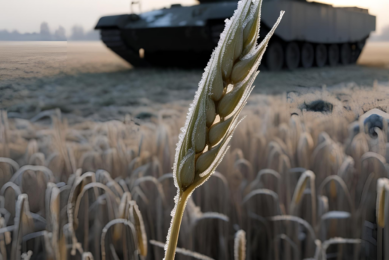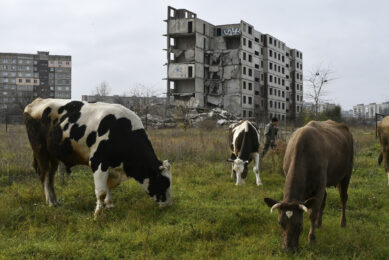Ukraine’s feed industry strong despite turbulence
![Most modern Ukraine feed mills belong to agricultural holdings.<br />[Photo: Vladislav Vorotnikov]](https://www.allaboutfeed.net/app/uploads/2020/12/001_729_rb-image-2790441.jpeg)
[Photo: Vladislav Vorotnikov]
Despite the unstable political situation in Ukraine, agriculture and feed production are still promising sectors. Here is a glimpse at the situation so far and what is expected in the coming years.
The Russian annexation of Crimea, armed conflict in the east of the country together with protracted political crisis has ruined many segments of Ukraine’s economy over the last 2 years. Some officials believe that it could take 10 years or even more for the country to get back in terms of economic advancement to the indicators of 2013. However, agriculture is a different story. Livestock industry despite serious turbulence remains strong, supporting the demand for compound feed. Today’s forecasts say that in the coming years feed output may rise due to increasing domestic demand and possible higher exports. However, the crisis has also brought a number of negative trends into the market; the rise in the volume of counterfeit production and poor quality compound feed. In the end, these factors may determine the situation not only in feed industry, but also within the country’s livestock business.
The low hryynia makes Ukrainian compound feed attractive
For 2016/17, Ukraine is expected to increase the volume of compound feed production by nearly 40%, bringing it to 11 million tonnes, according to a report by Vadim Shayan, President of the Interregional Union of Poultry and Feed Manufacturers of Ukraine.
Ukraine’s analytical agency UkrAgroConsult is much more careful regarding forecast. They estimated that production volume will increase with CAGR of 4-5% during the period of 2016-2020, reaching 8 million tonnes. According to Vadim Shayan, the main driver of growth could be further development of the larger agricultural holdings in the country as well as developing the export of compound feed to Turkey, Morocco and some other African countries and the European Union (EU). So far, Ukraine has been exporting on average 11,000 tonnes of feed per year and importing 30,000 – 40,000 tonnes per year. However, since the beginning of 2014, the situation has significantly changed primarily due to the devaluation of the country’s currency – hryvnia. As a result, Ukraine today has an average price of UAH 6-7 per kg (US$ 0.23-0.27) for compound feed, which is one of the lowest rates in Europe. This makes Ukrainian compound feed very attractive in terms of price to other countries.
Prospects for Ukraine’s feed market in December 2015 have been highly appreciated by the representatives of the Dutch bank ABN Amro.
Ukraine’s Agricultural Ministry Alexei Pavlenko claimed that the Ukraine market has a bright prospect and deserves a closer look from investors. Also according to him, the Netherlands could open its market for Ukrainian compound feed and other agricultural production during this year. “The Netherlands may open its market to Ukrainian products. At the same time, Dutch companies, based in Ukraine, could find new opportunities for selling their own products, which have been lost due to Russian sanctions. Therefore, Ukraine is attractive for the Dutch agricultural sector,” Alexei Pavlenko explained.

[Photo: Vladislav Vorotnikov]
Compound feed industry is monopolised
According to Andrei Kim, expert at UkrAgroConsult, Ukraine has increased its feed production from 2 million tonnes in 2004 to 6 million tonnes in 2014. At the same time, 87% of all feed production is by agricultural holdings which produce feed primarily for their own needs. According to the General Director of informational-analytical agency ProAgro, Nikolay Vernitsky, currently 60% of all feed in the country is poultry feed and 20% is pig feed. Both segments are highly monopolised as vertically integrated holdings produce 70% out of all feed for poultry and 60% out of all feed for pigs.
The largest producers of compound feed in the country are MHP with a capacity of 1.2 million tonnes, Agromars with 371,000 tonnes and UkrLandFarming (owns egg manufacturer Avangard) with 304,000 tonnes. Nearly 2 million tonnes of feed in the country falls for small and medium-sized producers which are forced to operate at only part of their capacities, hence suffering losses. Currently, most Ukrainian manufacturers have some ambitious plans for further growth in production capacities and this task will definitely require an increase of feed capacities. In particular, MHP targets to launch its first poultry processing facility in the Netherlands by mid-2016, as recently announced by the company. As a result, it is expected that this segment will continue to account for the largest part of industry growth, just as it did in the last few years. The situation for the industrial segment differs from the open market. Almost all investments attracted into the country’s feed industry have been brought by holdings, resulting in feed mills of the vertically-integrated structure having a much better technological base, profitability and quality of products, compared to independent players.
Quality issues impeding feed exports to EU
In total, there are around 200 companies engaged in production of feed in Ukraine, according to official data. However, the actual number could be bigger since some businesses are operating in the shadows, hiding small production cycles to avoid paying taxes.
“There are numerous mills which are working for the open market, where there is no vertical integration. Partly due to the strong competition they cannot operate at full design capacity. Feed mills in the structure of agricultural holdings operate at 80-90% of capacity, while independent operators only at 60%,” said Chairman of Union of Poultry Farmers of Ukraine Alexandr Bakumenko. Ukraine currently has the capacity to produce about 10 million tonnes of feed per year, but the consumption in recent years was estimated to be about 7 million tonnes, also giving the size of the so-called shadow market (feed production which is manufactured and used without proper control, and so not mentioned in official statistical data). Some experts believe that development of export markets may really support the development of small and medium-sized legal businesses for production of compound feed in Ukraine. At the same time, there are still some issues regarding certification and proper control. “With the exception of a few major players there are no companies that have managed to implement innovative solutions and bring the quality of compound feed to a competitive level,” addressed Nikolay Babenko, head of the Ukraine Center for Increase of Effectiveness of Livestock Industry. The poor quality and lack of certification is one of the main constraints that impedes export growth of Ukraine compound feed to Europe. “To comply with the demand of the EU in terms of quality we need to certify the whole process from grain production to manufacturing of compound feed mixtures. But finally, this will increase the cost of production, so it will be even higher than in Europe,” said Nikolay Vernitsky.

[Photo: Vladislav Vorotnikov]
Rising raw material costs encourage counterfeit
Almost all market participants agree that the rise in counterfeit will become a problem and pose a threat to the stability of small-scale farming in Ukraine. It is connected primarily with the rise in costs of feed production. According to Alexandr Bakumenko, feed prices spiked 40% since the beginning of the crisis, primarily affected by the increased prices of imported commodities. “Prices for animal feed have spiked, together with prices for grain, meal and cake of oilseeds, vitamins and other feed supplements, which also affected the level of demand. Here we are not talking about the demand in general, but about effective demand because prices for livestock products rose to a lesser extent than feed, and farm owners simply cannot afford to pay as much for compound feed as they did before,” representatives of Kiev Atlantic Ukraine explained.
As a result, some producers reduced the number of livestock last year. As a result of heavy price competition, some manufacturers started to change the formulation of compound feed production, replacing sources of amino acids, vitamins and nutrients in order to keep the visual specifications of the product the same, but decrease its production cost.
Trouble ahead if feed quality continues to fall
“The country’s market suffers from the lack of control, as [country’s veterinary service] Gosvetphitosluzba which is responsible for monitoring feed production in the country, have a lack of funding for such activity. Many livestock producers opt for the cheapest types of feed they can afford and do not have their own laboratories to test it and find out if the structure of the product on the label really corresponds to its actual composition,” said a representative of the livestock business who wants to remain anonymous.
He also added, that this situation causes real disruption in terms of feeding in the Ukraine, as farmers who try to study the effect of different feed ingredients are finding that despite the scientific data the use of some recommended substances does not increase the productivity. As a result, the real productivity of livestock business in Ukraine, according to him, showed a negative tendency in the last couple of years. If the quality of feed continues to deteriorate, it will bring further problems to farmers, he concluded.











